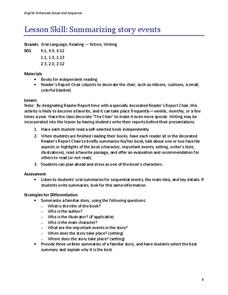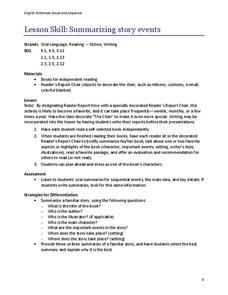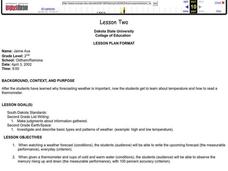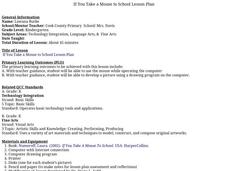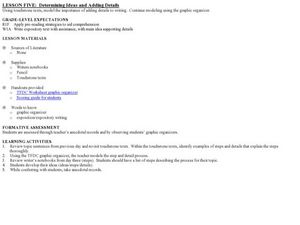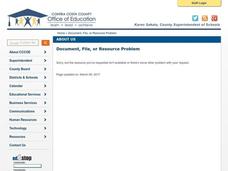Curated OER
A Tale of Two Frogs
Second graders locate Russia on a map or globe and work in pairs to complete the Map worksheet. They read the book, A Tale of Two Frogs stopping after page 15. They write an ending to the story and then read more of the book stopping...
Curated OER
Summarizing Story Events
After reading a book on their own, pupils prepare an oral report on the book, and sit in the "Readers Report Chair" when giving the report to the class. They are taught to briefly summarize the book by talking about one of two...
Curated OER
Summarizing Story Events
Here is a way to build your pupils' public speaking abilities. The lesson plan describes a reader's report chair, which is used each week by a student who has just finished reading a book. The featured reader sits in the chair and talks...
Curated OER
Let's Travel to Mexico!
Students investigate and explore information about Mexico. They listen to a story, view an Internet video, write a page for a class book, and play an online Spanish word concentration game.
Curated OER
Adjective Fun
Students investigate and then describe what an adjective is. Illustrations are made using their adjectives to describe a noun and to answer questions about the information gathered.
Curated OER
Introducing Literary Elements in Fiction
Identify literary elements in fiction. In this reading comprehension lesson, learners read the book Pigsty and record literary elements onto a graphic organizer. They specifically discuss the main characters and events in the text.
Curated OER
Cinderella in Africa
Explore African folk tales! After reading the African folk tale "Mufaro's Beautiful daughters" and the American version of "Cinderella," youngsters list differences and similarities between the two. Draw a T-chart on the board, and hold...
Curated OER
Sally's Super Day
Second graders engage in a lesson that is about having a super day with an example of a fictitious child. They read "Sally's Super Day" and reflect upon the events and how they affected the character and the outcome of the story. The...
Curated OER
Review Parts of a Book
Begin the year with a review of the parts of a book. Exercises in the unit plan ask emergent readers to identify the information on the cover of a book and on the title page, to explain the purpose of a table of contents, and to describe...
Curated OER
Colds and Germs
Students determine how diseases are spread from one person to another. They investigate the importance of hand washing to reduce the spread of common colds and other diseases. They listen to teacher read alouds and complete an inquiry...
Curated OER
Lesson Two
Second graders, after assessing why forecasting weather is important, study about temperature and how to read a thermometer. They experiment being able to observe the mercury rising up and down when given a thermometer and cups of cold...
Curated OER
Spelling-Silent Letters
Silent letters make spelling and reading an even more challenging task. You class can practice detecting silent letters with this printable handout. Learners can also complete the learning exercise as an online quiz. Note: Answer sheet...
Curated OER
Adjective or Present Participle?
Read ten sentences and choose whether the selected word in each sentence is an adjective or present participle verb. The answer sheet is provided.
Curated OER
If You Take a Mouse to School Lesson Plan
The book If You Take a Mouse to School is sweet, enjoyable, and so fun to read. Little learners hear the tale of Mr. Mouse and all the trouble he causes. They discuss the book as a large group and then split up into smaller groups to use...
Curated OER
Very Good Facts About Very Good Books
Young scholars identify the characteristics of fiction and non-fiction texts. In this genre study lesson, students read the books A Butterfly Alphabet Book and I Wish I Were a Butterfly. Young scholars develop a graphic organizer to...
August House
Anansi and the Pot of Beans
Anansi is a tricky character, but can he realize he's wrong and write an apology letter? Learners use Anansi and the Pot of Beans to practice writing, art, and figurative language. A series of activities are engaging for both...
Curated OER
Determining Ideas and Adding Details
A handy TFDC (topic/fact/detail/conclusion) graphic organizer (included) allows young writers to outline and record their main ideas and supporting details in the prewriting phase. They then continue to add details to the topic sentences...
BrainPOP
U.S. Symbols
United States symbols are the subject of a video brought to you by BrainPop Jr. Hosts, Annie and Moby, begin with a definition of the word symbol, then go on to detail ten American symbols—the American flag, a Bald Eagle, the Liberty...
Curated OER
Biographies
Students read a biography and discuss what defines a biography. Students choose a biography of their own interest to read and write a report about one of the people in the biography. Reports are shared with classmates.
Curated OER
All About Bats
Second graders research everything they know about bats. They find out anything about bats that was not discovered by the class and to come back and share the new information. They color their own picture of a bat and will write at least...
Curated OER
East Meets West
Students explore the influences of culture in food choices and customs. They compare and contrast information to create a menu using a Web site and Student Writing Center. Suggestions for creating an on-line graphic organizer as well as...
Curated OER
Freddy the Fish
Students complete an experiment. In this water pollution lesson, students brainstorm information about river habitats and water pollution. Students then read the story Freddy the Fish and complete an experiment where they use a...
Curated OER
Introduction to Sea Horses
Students identify different types of sea horses. In this sea horse research lesson, students learn associated vocabulary and listen as the teacher reads Elaine Landau's, Sea Horses A True Book. They visit assigned Internet sites to find...
Pennsylvania Department of Education
Comparing Key Ideas and Details in Fiction and Nonfiction
Students recognize the differences between fiction and nonfiction texts. In this genre study lesson plan, students discuss what nonfiction means and write the definition. Students listen to a read aloud and vote whether the text is...

